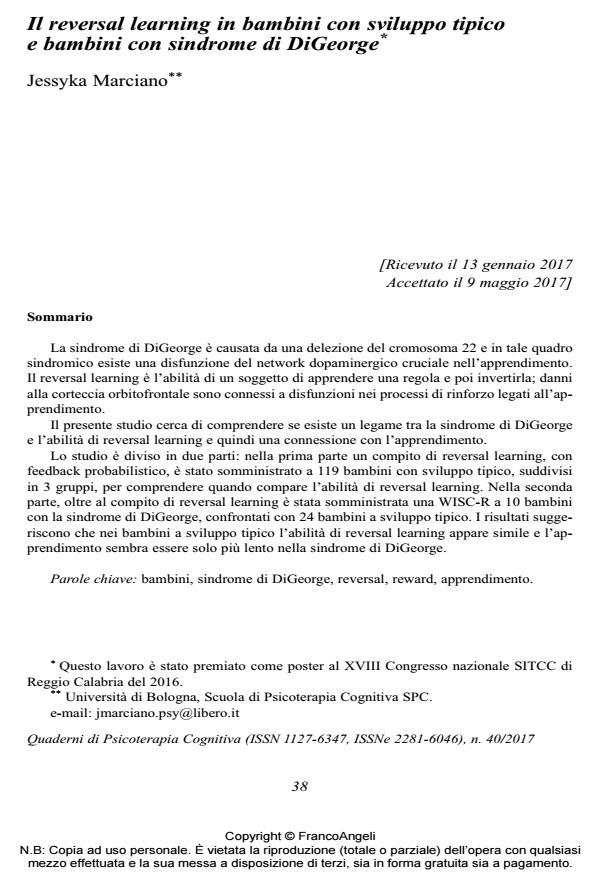Il reversal learning in bambini con sviluppo tipico e bambini con sindrome di DiGeorge
Titolo Rivista QUADERNI DI PSICOTERAPIA COGNITIVA
Autori/Curatori Jessyka Marciano
Anno di pubblicazione 2017 Fascicolo 2017/40
Lingua Italiano Numero pagine 18 P. 38-55 Dimensione file 143 KB
DOI 10.3280/QPC2017-040003
Il DOI è il codice a barre della proprietà intellettuale: per saperne di più
clicca qui
Qui sotto puoi vedere in anteprima la prima pagina di questo articolo.
Se questo articolo ti interessa, lo puoi acquistare (e scaricare in formato pdf) seguendo le facili indicazioni per acquistare il download credit. Acquista Download Credits per scaricare questo Articolo in formato PDF

FrancoAngeli è membro della Publishers International Linking Association, Inc (PILA)associazione indipendente e non profit per facilitare (attraverso i servizi tecnologici implementati da CrossRef.org) l’accesso degli studiosi ai contenuti digitali nelle pubblicazioni professionali e scientifiche
La sindrome di DiGeorge è causata da una delezione del cromosoma 22 e in tale quadro sindromico esiste una disfunzione del network dopaminergico cruciale nell’apprendimento. Il reversal learning è l’abilità di un soggetto di apprendere una regola e poi invertirla; danni alla corteccia orbitofrontale sono connessi a disfunzioni nei processi di rinforzo legati all’apprendimento. Il presente studio cerca di comprendere se esiste un legame tra la sindrome di DiGeorge e l’abilità di reversal learning e quindi una connessione con l’apprendimento. Lo studio è diviso in due parti: nella prima parte un compito di reversal learning, con feedback probabilistico, è stato somministrato a 119 bambini con sviluppo tipico, suddivisi in 3 gruppi, per comprendere quando compare l’abilità di reversal learning. Nella seconda parte, oltre al compito di reversal learning è stata somministrata una WISC-R a 10 bambini con la sindrome di DiGeorge, confrontati con 24 bambini a sviluppo tipico. I risultati suggeriscono che nei bambini a sviluppo tipico l’abilità di reversal learning appare simile e l’apprendimento sembra essere solo più lento nella sindrome di DiGeorge.
Parole chiave:Bambini, sindrome di DiGeorge, reversal, reward, apprendimento.
Jessyka Marciano, Il reversal learning in bambini con sviluppo tipico e bambini con sindrome di DiGeorge in "QUADERNI DI PSICOTERAPIA COGNITIVA" 40/2017, pp 38-55, DOI: 10.3280/QPC2017-040003